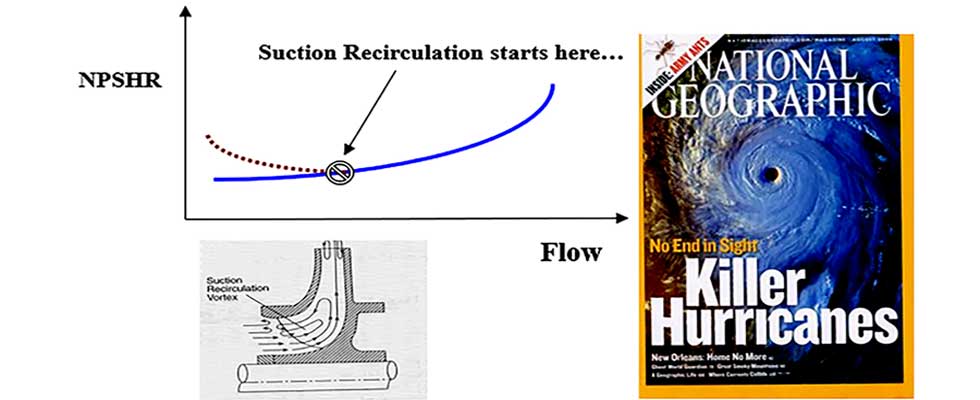
I received interesting comments and questions on my March 2020 article about issues with hot mechanical seals aggravated by improper operation outside the best efficiency point (BEP). One reader asked: Does suction specific speed (Nss) also depend on a specific pump type, or does the “9,500” number fit all? His question and my comments are below.
From the reader:
I was interested to read your “Is a Hot Mechanical Seal Temperature Always Bad?” article. I’ve read several articles on why pumps with high Nss should be avoided, but I’ve never seen an article on the relationship of the limitation of Nss with specific speed and impeller type. The Nss limitation seems to be “one size fits all” to me and I’d be interested to know if it’s applicable to all pump types, or just limited to radial flow centrifugal pumps.
Is the limitation of Nss to maximum “9,500” also applicable to mixed and axial flow impellers? Is there a particular specific speed (Ns) cut off where below a particular Ns value the maximum Nss should be limited? Is the limitation of Nss to maximum “9,500” applicable to all impeller types? Is it applicable to double suction impellers, vortex impellers, channel type impellers used for wastewater for example?
I’d be very interested to read an article that explained this.
Matthew Bailey MEng, CEng
Stantec, England
Thank you for your question. This is a great topic—general guidelines versus detailed calculations, and a trip through pumps hydraulics history may help.
Centrifugal pumps—like any type of machinery—started by trial and error, driven by the desire to get water flowing, without concern for efficiency, cavitation or anything related to science and calculations. A more engineering/analytical approach to pumps goes back only 100 years or so, by the time “formal” pump companies were established. Today, the engineering approach to pumps hydraulics has changed significantly.
 IMAGE 1. Sequence of what happens as a result of low flow (Images courtesy of the author)
IMAGE 1. Sequence of what happens as a result of low flow (Images courtesy of the author)Research of pumps hydraulics—improving efficiency (saving energy) and extending pump life via enhanced designs resistant to cavitation—was published by Igor Karassik, Warren Fraser and other pump hydraulics specialists. A famous paper by Karassik, “Flow Recirculation in Centrifugal Pumps: From Theory to Practice,” was published in 1981. At the annual American Society of Mechanical Engineers (ASME) meeting, the author used relatively small (under 20-inch) single- and double-suction centrifugal pumps to present his theory of predicting flow recirculation points.
Fraser, a colleague of Karassik, published a similar paper (“Flow Recirculation in Centrifugal Pumps”), including laboratory testing where he studied single-suction, double-suction and multistate pumps. In this paper, Fraser also developed graphics to relate Nss limitations at various Ns values, as far as recirculation regime onset.
In 1983, J.L. Hallam (“Suction Specific Speed is Important in Pump Failure Rates”) presented a study from the end user perspective (he worked at Amoco Oil) relating Nss and failure rate, and found empirically/statistically that after Nss surpasses 11,000, the rate of failures increased exponentially. Thus, 11,000 became a ballpark industrial yardstick of the Nss limit.
In the late 1980s, Elemer Makay, Paul Cooper and others added to the work of the Electric Power Research Institute (EPRI) to further develop the studies, linking practical field statistics of impeller cavitation life to analytics, with quantifiable graphs and formulae bringing the subject to a new level. Cooper’s publication “Perspective: The New Face of R&D – A Case Study of the Pump Industry” (Transactions of the ASME, December 1996, Vol. 118) presented an overview of the research and development, culminating with computational fluid dynamics (CFD), by which means a pump’s internal hydraulics can be modeled and analyzed in a fraction of time and cost as compared to the earlier methods of the empirical approach and testing experiments.
Despite developments in pump research (including work in cavitation studies), these methods primarily addressed the pump manufacturers’ needs. Users could not afford the time and investment of the complex laboratories to derive limits based on pump types, shapes and industrial uniqueness. The overall “one number fits all” approach was needed, and thus, a simplified, more conservative approach was taken. This is why the “9,500” became a choice by the Hydraulic Institute (HI), to limit Nss, regardless of the Ns or pump type. Similarly, the American Petroleum Institute (API) 610 specification for centrifugal pumps used in refineries limited operation of pumps to above 60 percent of the BEP (and below 120 percent), even though some pumps can extend operations outside these limits.
These rough guidelines became a pragmatic yardstick within purchasing specifications for pumps in critical services, while the less critical (usually smaller) pumps remain limited in flow operation based on the minimum continuous stable flow (MCSF) as noted on pump manufacturers’ performance curves.
Also, recirculation damage is not limited to cavitating impellers; the unsteady regime it induces cause pulsations, vibrations and other instabilities, damaging bearings, mechanical, seals, couplings, etc. Most users would adjust the operating flow to avoid low-flow operation.
A detailed knowledge and information of calculating the onset of suction recirculation is available in publications, as well as within the retained knowledge of pump manufacturers’ hydraulic designers. If your exposure to the pump world is mainly on the end user side, use the already published simplified guidelines, such as HI, API 610 or similar published specifications. True, the exact value of the flow where the onset of recirculation begins would vary for a double-suction cooling water pump, versus a multistage hot water boiler feed pump or a mixed flow vertical pump at the municipal plant. But, used conservatively, these values would help ensure safe and reliable operation and an extended impeller life.

